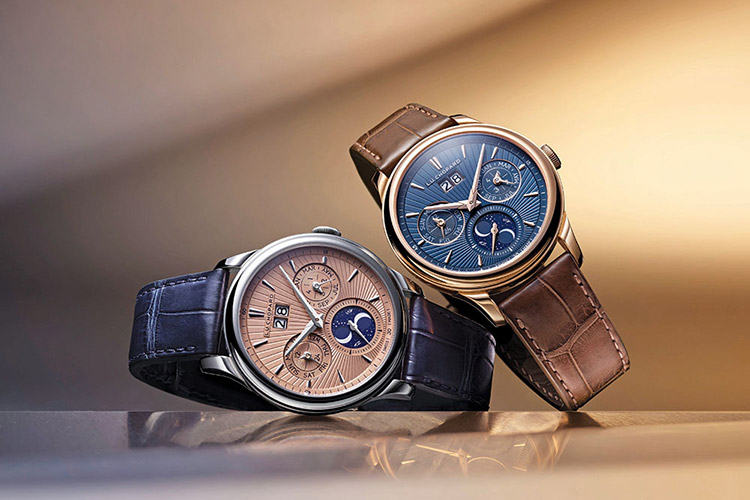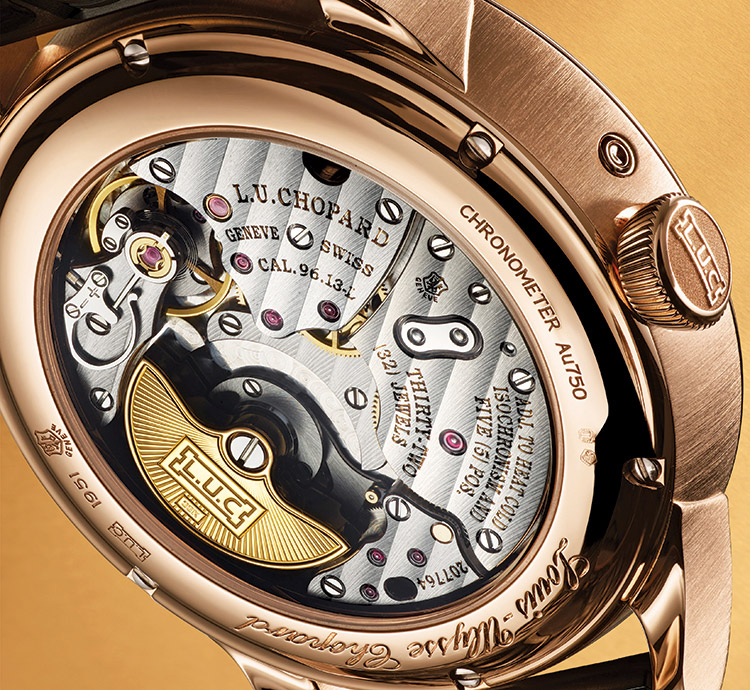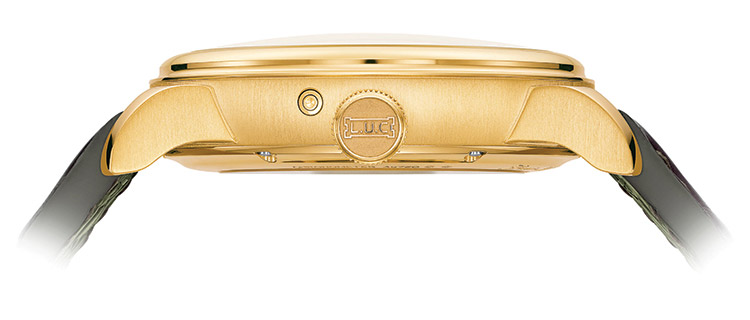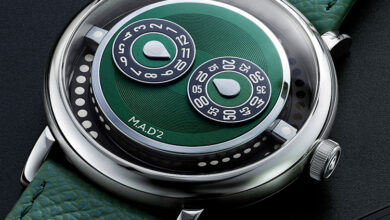
High watchmaker Chopard is debuting two new watches in its L.U.C collection. The Chopard Manufacture is creating a new milestone in its history with the L.U.C Calibre 96.36-L, an original high complication movement pairing a flying tourbillon and a perpetual calendar with large date display that is housed in the L.U.C Flying T Twin Perpetual. The L.U.C Lunar One, an historical L.U.C complication that combines the perpetual calendar with astronomical moon phase, now comes in a reshaped aesthetic
L.U.C FLYING T TWIN PERPETUAL
The L.U.C Flying T Twin Perpetual timepiece reflects the finest expertise and innovation cultivated by the Maison’s workshops. It features a case in ethical 18-carat yellow gold measuring 40.5 millimetres in diameter, with a slender, bassiné profile. This aesthetic refinement extends to the highly legible Forest Green dial in hand-guilloché gold, and an ingenious interchangeable strap system treats the watch to a variety of styles. While the movement’s accuracy is chronometer-certified, the high-quality finishing of this exceptional model has also earned it Poinçon de Genève recognition.
L.U.C Calibre 96.36-L
The history of Chopard Manufacture since 1996 has been dotted with landmark innovative models, the most recent of which is L.U.C Calibre 96.36-L. In 2013, the L.U.C Perpetual T model, Chopard’s first tourbillon with perpetual calendar, made its mark on the history of the Manufacture. Six years later, it was followed by the no less innovative L.U.C Flying T Twin, constituting the Manufacture’s first timepiece with flying tourbillon and automatic winding, as well as being the only one in its category to receive both Poinçon de Genève and chronometer certification.
Today, the L.U.C 96.36-L movement represents the culmination of these innovations. Illustrating the Manufacture’s constant quest to excel, it unites the finest previous feats in an unprecedented technical development involving no fewer than 319 components. Thanks to the micro-rotor and Chopard Twin technology’s two stacked barrels, the 6 mm-thick movement associates the lightness of a flying tourbillon with all the gear trains enabling this model to provide day of the week and large date displays, as well as a month indication, requiring no manual adjustments to keep track of variable month lengths and leap years. The perpetual calendar will need only a one-day correction on March 1, 2100 – not because of a fault in the mechanism, but due to the Gregorian calendar, which stipulates that centuries are leap years only if divisible by 400. The movement’s accuracy also ensures instantaneous display of all the perpetual calendar indications.
Distinguished by the absence of an upper bridge, the flying tourbillon of the L.U.C Flying T Twin Perpetual timepiece enables unobstructed views. Equipped with a stop-second function enabling the time to be set to the exact second, the tourbillon enhances the movement’s accuracy. This precision is chronometer-certified by the COSC (Swiss Official Chronometer Testing Institute), as is the case for all L.U.C calibres with a seconds indication – in this instance, located on the tourbillon carriage. A demonstration of technical virtuosity, the tourbillon – invented in the 18th century to eliminate the influence of the Earth’s gravity and isochronous forces – is one of the most sophisticated horological complications. Chopard’s flying tourbillon stems from several years of research and development, testifying to the Manufacture’s maturity. Finally, thanks to the energy accumulated in the two stacked barrels using Chopard Twin technology, the L.U.C Flying T Twin Perpetual timepiece is endowed with a 65-hour power reserve.
At 40.5 millimetres in diameter and 11.6 millimetres thick, the new case fits smoothly on any wrist. It features a bassine shape, meaning its base is narrower than its domed, polished bezel. Reflecting craftsmanship inspired by the pocket watches that emerged from Louis-Ulysse Chopard’s creative heritage in the 19th century, this distinctive profile creates an impressive sense of aesthetic refinement.
This new case with its vertical satin-brushed sides is paired with a curved, fluted crown that is not only elegant but also easy to handle. The slightly domed sapphire crystal perfectly matches the curves of the bezel, giving the watch a rounded, harmonious profile. Another sign of fine craftsmanship is that the lugs are made separately before being welded to the case to ensure a perfect aesthetic result.
Featuring a deep Forest Green shade, the dial of this new creation is itself naturally guilloché with a sunburst pattern radiating from the flying tourbillon opening at 6 o’clock, the focal point of this timepiece. A concentric snailed pattern runs around the dial periphery, below the minutes track. The hands and hour-markers are in yellow gold. The Chopard perpetual calendar highlights the most frequently requested indication – the date – through a broad twin aperture at 12 o’clock, while the two gold-rimmed perpetual calendar counters are also snailed, with the exception of the central section of one located at 9 o’clock. The latter is dedicated to the 24-hour indicator, which also serves as a day/night display. The upper part (day) bears a sunburst pattern symbolising the presence of the Sun, while the lower section is engraved with a horizontal motif evoking the serenity of the night.
L.U.C LUNAR ONE
Since being the first ‘calendar and astronomy’ complication presented by Chopard Manufacture in 2005, the L.U.C Lunar One model has remained the only timepiece in its category equipped with a precision orbital moon-phase display featuring a rotating window. The mechanical self-winding L.U.C Calibre 96.13-L with perpetual calendar and astronomical moon-phase function – achieving a rare degree of accuracy guaranteeing a single day’s difference in 122 years – powers two new timepieces whose profile has been reshaped in line with the latest L.U.C aesthetic. Framed by a 40.5 mm-diameter case in ethical 18-carat gold, the hand-guilloché dial demonstrating artisanal expertise is distinguished by highly legible indications, while an ingenious interchangeable strap system offers a variety of styles. While the movement’s accuracy is chronometer-certified, the high-quality finishing of these two L.U.C Lunar One models has also earned them Poinçon de Genève recognition.
L.U.C Calibre 96.13-L
The L.U.C Lunar One timepiece equipped with the L.U.C 96.13.L chronometer-certified movement illustrates the trajectory of the moon with remarkable accuracy. Its perpetual calendar with orbital moon phases clearly indicates the date, day, month, and leap years. It also features an additional 24-hour scale. The night star rotates around the small seconds axis, hence the term ‘orbital’. The movement represents the sky as seen from the Northern Hemisphere with the Big Dipper; as well as from the Southern Hemisphere with the Southern Cross. Calibrated by Chopard’s finest watchmaking Artisans, this display boasts astronomical precision: with a time difference of just 57.2 seconds between two moons, it will take 122 years for it to show a one-day discrepancy with the real moon. Only then will it need to be adjusted.
Reflecting Chopard Manufacture’s perpetual quest for slenderness, the L.U.C Lunar One timepiece is also one of the very few self-winding perpetual calendars to feature a micro-rotor. The latter is made of solid gold and integrated into the movement thickness, thereby slimming it down and enabling it to be admired through the sapphire crystal pane fitted on the case-back. Engraved with the L.U.C logo and finely guilloché, this micro-rotor heralds the extreme degree of finishing lavished on L.U.C Calibre 96.13-L – of which all 355 components are produced, hand-decorated and assembled in the Manufacture’s workshops. Thanks to the two stacked barrels of Chopard Twin technology, the L.U.C Lunar One model is also endowed with a 65-hour power reserve.
While these two new timepieces are joining the L.U.C Lunar One family, they differ from their predecessors with a slimmer case, subtly reshaped in line with the L.U.C collection’s latest aesthetic codes. At 40.5 millimetres in diameter and 11.6 millimetres thick, they fit smoothly on any wrist. Crafted in ethical 18-carat white or rose gold, the case features a bassine shape, meaning its base is narrower than its domed, polished bezel. Reflecting craftsmanship inspired by the pocket watches that emerged from Louis-Ulysse Chopard’s creative heritage in the 19th century, this distinctive profile creates an impressive sense of aesthetic refinement.
This new case with its vertical satin-brushed sides is paired with a curved, fluted crown that is not only elegant but also easy to handle. The slightly domed sapphire crystal perfectly matches the curves of the bezel, giving the watch a rounded, harmonious profile. Another sign of fine craftsmanship is that the lugs are made separately before being welded to the case to ensure a perfect aesthetic result. This reshaped design makes the L.U.C Lunar One a timeless object for watch connoisseurs and paves the way for the aesthetics of future timepieces in the collection.
Meticulous work is required to ensure that each dial intended for these new L.U.C Lunar one models – available in a choice of deep blue or salmon pink colours – is adorned with a sunburst guilloché pattern radiating from the moon-phase indicator at 6 o’clock, the focal point of this timepiece.
One particularly distinctive feature of the L.U.C Lunar One model is the large twin-aperture date window at 12 o’clock. A concentric snailed pattern runs around the dial periphery, below the minutes track. The Dauphine fusée hands and herringbone-type hour-markers are in white or rose gold matching the case. The two perpetual calendar counters are also snailed, with the exception of the central section of the one located at 9 o’clock. The latter is dedicated to the 24-hour indicator, which also serves as a day/night display. The upper part (day) bears a radiating pattern symbolising the presence of the Sun, while the lower section is engraved with a horizontal motif evoking the serenity of the night. Ultimately, the arrangement of each indication is both aesthetically pleasing and perfectly legible.











